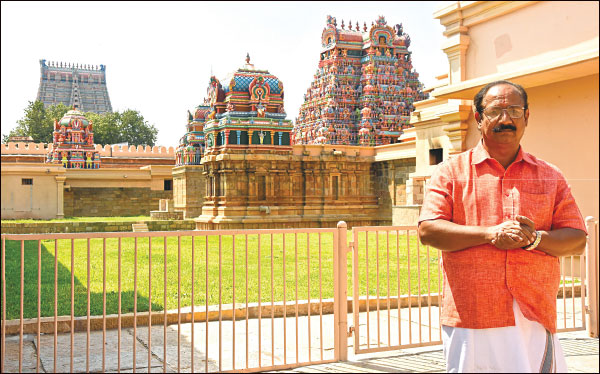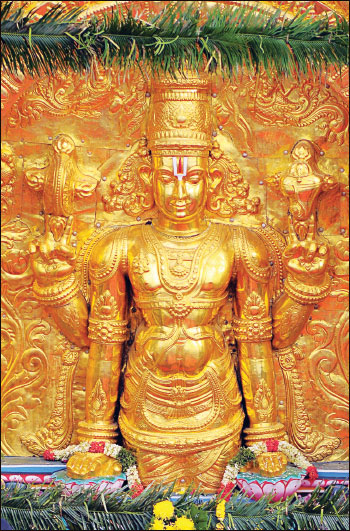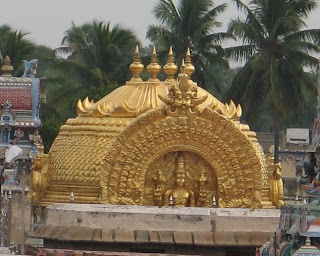01Rangarajyam
Ranga Rajyam: New series
இந்திரா சௌந்தர்ராஜன்
Author: Indira Soundarrajan
படங்கள்: என்.ஜி.மணிகண்டன் Photos: N.J. Manikandan
My Salutation to my Readers!

Rangarajyam topic is a serial publication of
articles about worship and adoration of Azvars, Sundara Kāṇdam, Kaṇṇaṉ
Varuvāṉ…
Tiruvaraṅgam, the centerpiece of this series,
is the first and the foremost among Divya Dēsams, known as Bhūlōka
Vaikuntam. The Lord in the center is none other than Araṅganātha Perumāḷ
who projects the appearance of sleeping in the state of Tāmasa Nidra.
Araṅgaṉ is not only the leading Lord of the
series but also the Lord of the fourteen worlds. The background history
of this temple occupied by the earthbound Bhagavan has a multitude of
ambrosial news. It is the eponym for Kōil (Temple). We realize its
primeness and greatness, historical significance and its reputation as
the repository of wonders, compared to other earthbound temples.
But, this Tiruvaraṅgam Kōil goes beyond the
ancient history, connected with Puranas and embodying multiple rare
structures. Because of them, the eleven Āzvārs performed benedictions on
this sacred temple. The temple is the reason for the attainment of
Paramapadam by Srī Vēdānta Dēsikaṉ, Tiruppaṇāzvār, Srī Rāmānujam, and
others.
This Bhumi has the fame to have given birth to
Periya Nambhi, the Guru of Srī Rāmānujar, Lokāchāriyār, the repository
of Vaishnavism. The seven courts having an abundance of subtle inner
meaning are uniquely special for this temple.
When we think of the numeral seven, our
thoughts expand to dwell on the seven births, seven wonders, seven Sabda
Svarams, seven colors (of the rainbow), and seven Ṛṣis.
We are made of five elements and obtained
intellect the sixth sense, because of which we have the blessing of the
seventh faculty namely Sabda (Vaikari speech), and the eighth faculty of
mind, which helps us reach the ninth namely the holy feet of God. These
are the nine-step explanation of the numerals one to nine. Seven holds
the preeminent place and in Tiruvaraṅgam constitutes the seven
Prakārams. Circumambulation along these seven walkways and worship of
Araṅgaṉ guarantee resolution of the merits and demerits accumulated over
the seven births.

Only upon resolution of Karma, we can take
refuge at his holy feet. Such is the inner meanings of the subject. We
are proud of the growth of Prabhandam Tamil. Ahead of us, we have a deal
of matter regarding Araṅgaṉ to be apprehended in its subtilities. I
humbly pay homage to Araṅgaperumāṉ. Follow the holy Araṅgaṉ of
Tiruvaraṅgaṉ.
This world.
It was the time in this world of Ikṣvāku of
the Solar race. In his period, the worshipful Tiruvaraṅga-p-Peruman,
whom we celebrate having him on our head, came down from Satya Loka the
world of Brahma to Bhūlōka (our world).
In this world of ours, there are countless
temples, of which there are self-existent and human-made structures. The
latter example is the Rāja-rāja-Chōzan’s, Brihathīsvarar Temple.
Tiruvaraṅga-p-Peruman Temple is the only one that descended from the
heavens to the earth.
Ikṣvāku of the solar race provided it for the
earth dwellers. We cannot ascertain his period of reign at Ayōdya as the
capital. We can estimate an approximate period of his reign.
It is essential to learn about the 14 Manus.
Knowing them will help us arrive at the estimated reign of Ikṣvāku. By
this, we can ascertain ancient particulars of Tiruvaraṅga-p-Perumāṉ, to
whom we offer our worship.
We are in the year 2018. If we go back from
the beginning of the Christian era calendar by many thousands of years,
we can offer an approximate estimate. Let us begin with our Emperuman.
There were no oceans, no era, and no kingdoms. Before the lifeforms like
fly, ant, worm, insect, rodents, birds, fish, and the legged came into
existence, only Perumāṉ existed.
Perumāṉ created from himself the four-faced
Braḥma, and from the latter, he again created the four Vedas, the
universe of sound. Later, the fourteen worlds and the lifeforms came
into existence.
The seven worlds above the earth are Bhuvaha,
Suvaha, Janaha, Tapaha, and Satyam. Below the surface of the planet
earth, Ataḷa, Vitaḷa, Sutaḷa, Rasātaḷa, Taḷā, Mātaḷa and Pātāḷa are the
seven worlds. Besides these, Śrīraṅga Mahātmiyam states, there are
starry heavens, Sapta ṛṣi Mandala, Vāyu, Agṉi, Varuṇa, Indra, Surya, and
Chandra.
Altogether, 14 worlds, Vedas, Higher
lifeforms, and the entity of Time came into being. Kṛta Yuga, Trēta
Yuga, Dvāpara Yuga, and Kali Yuga came into being. Kali Yuga of the
duration of 432,000 years, started on 18 February 3102 BCE. Dvāpara Yuga
is double the duration of Kali Yuga. Treta Yuga is triple the length.
Kṛta Yuga is quadruple the length.
We try to comprehend all these imaginations
with our small brain; what we end up with is tiredness. Brahma appointed
14 Manus to preside over these Yugas. Vivasvān was the seventh Manu,
whose son Ikṣvāku made it possible for Araṅganātha-p-Peruman to come
down to earth in his divine holy Archa form seated in the shrine with
Praṇava dome. Kali Yugas preceded by Dvapara, and Treta Yugas were the
Yugas when SrīRāmaprāṉ was ascendant.
The erstwhile Dvāpara Yuga was the Mahabharata
period when Krishna was on the ascent. Later, Kali Yuga began, and this
is when and where we remain now. High imagination is required of us to
visualize the erstwhile Yugas. Some calculated time periods based on the
events of Mahabharata in Dvapara Yuga. We understand to a certain
extent, for now, the beginning of the Bharata war.
Even before that Yuga, Emperuman’s
Svayam-vyakta (spontaneous self- manifestation) holy body by the grace
of Ikṣvāku came down to earth.
Why should it come down to earth from the
heavens? Why did Ikṣvāku bring it down? Let us look at the events.
Duality rules life on earth: Night and day;
happiness and grief. It will remain that way into the future. This
duality presupposes and assures life is changeable and interesting. That
is the nature of the world.
If there is sweetness, there is bitterness and
so is the case with joy and grief; night and day; man and woman. We must
add merit and demerit (sin) in this list. Man’s life revolves on the
principle of duality.
Human life runs on the two wheels of merit and
demerit. Only humans and not animals are subject to this duality. Man
because of his rational intellect knows himself and the world and lives
by the dictates of the past, the present, and the future. For other
lifeforms, instinct rules their lives. Their intellect was meager. They
lack the self-knowledge or the knowledge of the world. Therefore, they
are not subject to merits or demerits.
Man, with the knowledge of self and the world
he lives in, is subject to merits and demerits. Later, the experience of
heaven, hell, and rebirth are the norms.
Life was conferred on us to divest ourselves
of this duality and attain his sacred feet. Though we know of it, we
live in this world by doing meritorious deeds, and we redeemed ourselves
from the life of sin, they all appear insurmountable. To make this
transcendence possible, Emperuman sent us the Gurus for our guidance and
benefit. He establishes himself in the earth temples, makes us worship
him, grants us spiritual knowledge, cuts the fetters of rebirth and
liberates us.
In Ayodhya, having ruled in the solar race,
Ikṣvāku the son of Vaivasvata Manu had the dawn of spiritual thoughts in
his life. He saw and realized the inexorable changes in every fleeting
second in his body and tissues, the ravages of time on his youth, the
onset of old age, the unexpected maladies, and the death of the loving
near and dear. All these adverse events impressed on him, ‘Mutability
only is immutable in this world.’ These events made him realize the
truth no one in this world ever lived or will ever live with eternal
youth and inexhaustible power.
The thoughts that old age is imminent and life
one day will end oppressed (bothered) him. This oppression raised the
question, ‘What is the fulfilled and complete life?’ The answer came
from his father, Manu.
Descending from the heavens, Manu addressed
his son, ‘You seem to be in a reverie.’ He said, ‘Yes, father. One
moment is dissimilar to the next moment. Sometimes, changes give
joyousness and other times grief. I trembled and agonized with hunger,
alone on my hunt. A question arose, “Was there a way to remain free of
hunger?’
It dawned on me it is feasible to appreciate
the taste and texture of food only when hunger strikes you. “Life
revolves around duality. Is there a state other than duality?”
“Son! I understand your inquiry, which on your
part is good in a way. If not, would you have raised the question with
me?”
“Is this the answer to my question?”
“I will answer the question for you soon. The
answer is not for you only. It is also for all beings born on this earth
just like you.” With this introductory remark, Manu said Brahma living
in Satyaloka was his creator and the daily worshipper of Srīmaṉ
Nārāyaṇaṉ in his form of Yoga Nidra. Ikṣvāku listening to this was in
amazement.
“Son, Braḥmaṉ was my father and mother. He
blessed me with the Yoga Nidra form saying, ‘He was the cause of the
creation of you and I. All forms came into being by his grace and
effort. We came from him. Worship by me and others gives me joy.’ I
offered flowers in the worship of his body enshrined in and associated
with the Praṇava-shaped golden domelike turret. Because of it, I was the
recipient of unalloyed joy and permission to worship him.’ Hearing this,
Ikṣvāku looked at Manu with wonder.
“Why do you look at me like that?”
“Would I be a recipient of that joy and
tranquillity?”
“The moment this question dawned on your mind,
that moment you came to the place of the Muktaṉ. (Muktaṉ in Saivism is
one who is liberated even before death [Jivan Mukti]. In Vaishnavism,
Mukthi or liberation comes after the death of the deserving soul [Videha
Mukti]. We all have our duties. Mine is that of administering the Yuga,
while yours is maintaining your kingdom on earth. Go in search of the
path for liberation, while you perform your duties. Your dedicated Guru
Vasiṣṭha Muni will show you the correct path.” So, said the father.
Ikṣvāku said, “Let the Guru’s grace and path remain in abeyance. Will
you not bless me, and reveal the Mūrthy enshrined in Omkāra Vimāṇam (The
domelike Om-shaped Turret as the roof of the sanctum housing Araṅga
swāmy)?

Vaivasvatha Manu said, “The wonder of wonders,
I witnessed because of the grace and mercy of Brahma and my duty. Brahma
had a vision of him because of his severe austerities. Based on the
details I give you, build a mental temple and worship with your mind.
Your desire in due course of time will bear fruits.” Manu described
Tiruvaṅgaṉ and the sanctum with the Om-shaped dome wherein he lives.
Will Continues.
------------------------------------------------------------------------------------------------------------------------------------------------------------------------------------
![]()
Bhagavan’s Dasāvatāras (= 10 Avatars) teach us that in conformity with
the biological evolution, the Avataras came down to earth.
|
மச்சாவதாரம்: நீரில் வசிக்கும்
மீன். |
Matsya Avatar:
The fish living in the water. |
|
கூர்மம்: நீரிலும் நிலத்திலும்
தென்படும் ஆமை. |
Kūrma
Avatar: The turtle in water and earth. |
|
வராகம்: நிலத்தில் வசிக்கும்
பன்றி. |
Varākam: The
earth-living boar. |
|
நரசிம்மம்: விலங்கு நிலையும்
மனித நிலையும் கலந்தது. |
Narasimham:
Animal-Man combination. |
|
வாமனர் : குள்ள மனிதனாக
இருந்து த்ரிவிக்ரமனாக விஸ்வரூபம் அடைந்தது உருவ வளர்ச்சியைக்
குறிப்பது. |
Vāmaṉar: The
Dwarf incarnate, that attained Viśvarūpam as Trivikrama,
indicates growth of form. |
|
பரசுராமர் : கோபம் கொண்ட மனித
நிலை. |
Paraśurāma:
Man’s state in anger. |
|
பலராமர் : சாதாரண மனித நிலை. |
Balarāma: the
state of ordinary man. |
|
கிருஷ்ணன்: விளையாட்டும்
வினையும் கலந்த மனிதத் தன்மை. |
Krishna: Play
and deed, the condition of man. |
|
ராமன் : பொறுமையுடன் விவேகம்
நிறைந்த மனிதத் தன்மை. |
Rama: Patience
and wisdom in man. |
|
கல்கி: மனித நிலையைக்
கடந்தது. |
Kalki: A state
beyond human nature. |
|
-
சிலம்பொலி செல்லப்பன்
ஒரு சொற்பொழிவில் பேசியது. = Silapoli
Sellappan expressed his observation in a lecture.
|
|
255-204-255